Have you ever heard of the term “mobile friendly” in relation to websites? What does this phrase exactly mean? Does it simply signify that those who are accessing the Internet from a mobile device such as a smartphone or tablet can visit the portal in question? In the simplest of terms, yes. However, much more is involved when developing a mobile-friendly portal than may initially meet the eye. If your brand has been falling short of its targets in regards to inbound hits, the chances are high that this could be an issue related to mobile compatibility. This is why it is a good idea to take a look at few of the most important points to address when building mobile-friendly web pages as well as some of the advantages of outsourcing these concerns to a professional third-party e-commerce platform or white label provider.
Mobile-Friendly Architecture at a Glance
YouTube contains a fair number of videos which show users attempting to connect to the modern Internet with an older operating system such as the original version of Windows. It is interesting to note that the web can actually be accessed via such means. However, the main issue is that many elements within pages (such as a search engine or a news website) are unable to display correctly while other portions including flash videos fail to appear whatsoever. This very same principle can be applied to websites that have not been modified to work together with mobile technology. Some of the segments which can prove to be problematic include:
- Certain blocks of text.
- Contact buttons and similar widgets.
- Multimedia files.
- High-resolution graphics.
It should therefore be important that these areas are addressed from the very beginning. Let’s never forget to mention that pages which fail to correctly display will reflect negatively on the entire brand. Customers are more likely to navigate to another website and as a result, potential revenue is lost.
Why Choose an E-Commerce Provider?
Many well-known e-commerce solutions such as Magento offer a host of unique services. Unfortunately, their architecture can be difficult to understand and it is not as flexible as some modern alternatives. This is why Magento migration often involves utilising the utilities of more agile and intuitive services such as those offered by Shopify.
The good news is that mobile-friendly coding solutions are already built into the associated applications and digital elements. This out-of-the-box sense of functionality will take much of the guesswork out of the equation if you have been looking to adapt to the mobile community. Thanks to flexible pricing packages as well as a free trial period, you can also determine whether or not such an e-commerce option is the best choice for the needs of your business.
Mobile-friendly web hosting solutions are here to stay. While individuals may still access the Internet from personal computers and laptops, a growing number choose to interact while out and about. Making the appropriate changes today will help to ensure a bright future.





